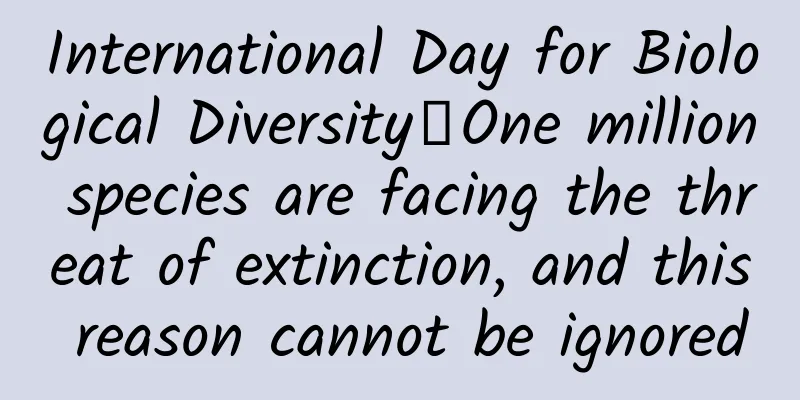International Day for Biological Diversity丨One million species are facing the threat of extinction, and this reason cannot be ignored

|
Climate change has always been a global concern, but what is less known is that, because of climate change, an equally destructive biodiversity crisis is spreading, with the number and species of plants, animals and other organisms declining sharply. May 22, 2023 is the first International Day for Biological Diversity after COP15 adopted the "Kunming-Montreal Global Biodiversity Framework", and it is also the 30th anniversary of the opening of the Convention on Biological Diversity for signature. Today, let's focus on the loss of biodiversity exacerbated by climate change. Written by Zhu Yehua Editor | Wang Hengting Biodiversity, in layman's terms, is the number of species in a place or on Earth. In recent years, the scientific community has reached a consensus that biodiversity on Earth is declining. This is not good news, because generally speaking, the more species there are in an area or ecosystem, the higher its biodiversity. This complexity and diversity creates healthy ecosystems and makes the Earth a perfect place for us and all other inhabitants to live. Once biodiversity is seriously endangered, it will bring unpredictable impacts. 01 Why is biodiversity important? In the web of life, all species are connected through interactions. Healthy ecosystems require a wide variety of plants and animals, from soil microorganisms to top predators like bears and wolves. If one or more species disappears from this environment and no longer serves its niche, it harms the ecosystem. Introducing foreign or invasive species into a habitat can have similar results, as invasive species can outcompete native species for food or territory. An often cited example is the impact of the hunting of wolves in Yellowstone Park. In 1930, the wolves in Yellowstone Park were hunted to near extinction, which caused the elk population to grow rapidly without its natural enemies, and also affected species that seemed unrelated to the wolves, such as plants, birds, and beavers. When the wolves were reintroduced to the park in 1995, they preyed on elk again, and plants and birds, beavers, fish, and other animals returned to the riverbanks. Many inconspicuous creatures play a more important role than we think. For example, dragonflies, ladybugs and beetles pollinate many of the crops we rely on for food and plants in natural ecosystems. Habitat loss, such as when humans turn grasslands into parking lots or backyards, will reduce the number of pollinators. If pollinators disappear completely, we will lose more than a third of our crop yields. The supply of foods that people like, such as honey, chocolate, berries, nuts and coffee, will also be greatly reduced [1]. So in order to balance biodiversity and create a rich ecosystem, the role of each species is important, and species serve each other to survive, and the same is true for humans. Biodiversity also provides ecosystem services or benefits to humans. These benefits include: hurricane storm surge protection, carbon sequestration, water filtration, oxygen production, and recreational opportunities. Without countless unique ecosystems and their respective diverse plants and animals, human quality of life could be threatened. Now, multiple scientific studies have found that biodiversity is in dramatic decline. Habitats are being destroyed and degraded, and natural resources are being exploited in an unsustainable way. The world's biodiversity integrity - a measure of how much pristine nature remains in any given area - is well below the "safe limits" required for the ecological processes we depend on. 02 What causes biodiversity loss? The 2022 Living Planet Report published by the World Wildlife Fund found that the number of mammals, fish, birds, reptiles and amphibians worldwide has declined by an average of 69% since 1970[2]. As early as 2017, a research report found that nearly 600 plant species have disappeared worldwide in the past 250 years, and the extinction rate is 500 times faster than predicted by nature. In 2019, the landmark Global Assessment Report released by the Intergovernmental Platform on Biodiversity and Ecosystem Services stated that 1 million animal and plant species are currently threatened with extinction. After years of research and tracking, scientists have found that biodiversity loss is caused by a range of different pressures, from habitat loss due to agricultural expansion, pollution or desertification, to invasive alien species and climate change. The root causes of all problems have one thing in common: unsustainable use of land and resources. Human activities have changed more than 70% of ice-free land. When land is converted to agriculture, some plants and animals may lose their habitats and face extinction. The Earth’s biodiversity and human societies face pollution, over-consumption of natural resources, urbanization, demographic change, social and economic inequality, and habitat loss, many of which are exacerbated by climate change[3]. Climate change is altering marine, terrestrial, and freshwater ecosystems around the world, exacerbating the impacts of other stressors on nature and human well-being. 03 The “escalating” impact of climate change To many people, the term "climate change" feels like a buzzword that carries a lot of negative implications. Climate refers to the average weather conditions in a region over a long period of time, usually 30 years or more. The climate of a region includes the air, water, land, and biological systems. Climate change is a shift or unusual change in weather patterns. As the Earth warms rapidly, mostly due to human activities, weather patterns around the world will fluctuate. Ecosystems and biodiversity will be forced to fluctuate with changes in regional climates, which could cause harm. While not the main driver of biodiversity loss, climate change is still a very important factor and is likely to ‘rise’ in importance as it intensifies. Progressive climate change will alter the distribution, function and interactions of organisms and wider ecosystems. As global temperatures rise, some species are being forced to leave the regions where they have evolved for millions of years and move to places where they can escape rising temperatures, such as up mountains or north. But because we’ve taken so much space away from nature, sometimes there’s nowhere to go. So populations that can’t migrate or adapt, like some plant and insect species, face the risk of becoming locally extinct. That, in turn, will reduce the genetic diversity of entire species, making them more vulnerable to pests and diseases and other stresses. If this happens to the food crops we rely on, it could devastate food systems and put millions of people at risk of malnutrition and famine. It’s not just rising temperatures from global warming that are a threat to biodiversity. The growing climate crisis is melting ice and snow, rising sea levels and eroding important coastal ecosystems. A study published in the journal Science in 2022 estimated that human activities have altered about 75% of the Earth's land surface and 66% of its oceans. This has led to the disappearance of about 80% of mammalian biomass and 50% of plant biomass, while more species are at risk of extinction than at any time in human history. Since every organism has a certain tolerance range for changes in its environmental conditions (such as temperature), global warming also leads to changes in species' habitats. Migrant species follow their temperature range and migrate towards the poles, higher altitudes (land, mountains) or greater depths (ocean). Sessile organisms such as corals can only change their habitat very slowly, over the course of a few generations: they are therefore caught in a temperature trap, which means that in the long term, large coral reefs could disappear completely. Moreover, if they can no longer find a habitat with a suitable temperature for survival, migratory species may also fall into a climate dead end in the form of mountain tops, coasts of land and islands, the poles and the depths of the ocean. From this perspective, global warming and the destruction of natural habitats not only lead to biodiversity loss, but also reduce the capacity of organisms, soils and sediments to store carbon, thereby exacerbating the climate crisis [3]. According to a report from a group of leading global ecosystem and biodiversity organizations, climate change will be the fastest cause of species loss in the Americas by mid-century. The report shows that factors such as climate change, land degradation and habitat loss are becoming the biggest threats to wildlife around the world. In Africa, it may cause some animal populations to decline by up to 50% by the end of the century, and up to 90% of coral reefs in the Pacific Ocean may be bleached or degraded by 2050. Many other threats still challenge the world's biodiversity, from pollution and overdevelopment to land use changes and habitat loss, and in many places these threats remain a greater direct threat to the world's wildlife than climate change [4-5]. Just as climate change leads to biodiversity loss, biodiversity loss leads to climate change, and this cycle continues, escalating as the situation escalates. 04 Benefits of taking action A series of research reports have stressed that actions to tackle global warming are also actions to benefit wildlife, and protecting the world's remaining natural environments is also a step towards protecting the climate. When human activities produce greenhouse gases, about half of the emissions remain in the atmosphere, while the other half is absorbed by land and oceans. These ecosystems – and the biodiversity they contain – are natural carbon sinks, providing so-called nature-based solutions to climate change. For example, protecting, managing and restoring forests accounts for about two-thirds of the total mitigation potential of all nature-based solutions. Although forests are suffering large-scale losses, they still cover more than 30% of the Earth's land, so biodiversity is also crucial to limiting climate change. Governments have proposed solutions, plans and international agreements to address the long-term problems of biodiversity loss and climate change. As individuals, we can take small actions in our daily lives to reduce our impact on the earth's environment: unplugging unused appliances, switching to energy-saving light bulbs, and green travel are all beneficial ways we can help slow climate change and protect ecosystem diversity. References: [1] https://www.nytimes.com/2016/02/27/science/decline-of-species-that-pollinate-poses-a-threat-to-global-food-supply-report-warns.html?_r=0. [2] https://livingplanet.panda.org/en-US/. [3] https://www.science.org/doi/10.1126/science.abl4881. [4] https://www.scientificamerican.com/article/climate-change-is-becoming-a-top-threat-to-biodiversity/. [5] https://www.un.org/en/climatechange/science/climate-issues/biodiversity. This article is supported by the Science Popularization China Starry Sky Project Produced by: China Association for Science and Technology Department of Science Popularization Producer: China Science and Technology Press Co., Ltd., Beijing Zhongke Xinghe Culture Media Co., Ltd. |
>>: Today, I pay tribute to the dreamers in the rice fields!
Recommend
How does WeChat Reading use social networking to increase user growth?
WeChat, with 1 billion users, has long been at th...
Operational Practice: How to operate an e-commerce mini program from 0 to 1?
Entering 2018, the blockchain craze has cooled do...
When will the Anhui epidemic end in 2022? When will the ban be lifted? Attached the latest news
Recently, many provinces and cities including Huna...
"Zhehaiyan C50", a netizen caught a coded fish and its origin was found!
Recently, a Taizhou netizen @小羊驼 asked for help o...
Ministry of Industry and Information Technology: In the first half of 2022, my country's lithium-ion battery production and industry revenue exceeded 480 billion yuan, a year-on-year increase of 150%
In the first half of 2022 , driven by the goals o...
The process of setting up a Toutiao information flow advertising account!
This article will tell you about the process of s...
Live broadcast account operation course
Introduction to live broadcast account operation ...
User Operation | The underlying logic and operation guide of the user churn model!
To do a good job in user operation , the first st...
These mobile phone functions and skills can solve holiday battery anxiety
Although there has not been a revolutionary impro...
Kang Zhijun's "The Human Side of Enterprise" Intensive Study Class
Kang Zhijun's "The Human Side of Enterpr...
Microsoft's immortal dream of mobile phones
[[337819]] The long-awaited Surface Duo, Microso...
What are open links and black links? Things to note when buying open links and black links!
The day before yesterday, when I was chatting wit...
91 Ten Articles: Tokyo Motor Show announced cancellation, Tesla has caused 175 deaths in eight years
1. Tesla Vice President Tao Lin recently admitted...
Why has Google failed to get Android development on track?
Introduction It's 2015 now, mobile is the new...
How can one have a photographic memory?
Source: Dr. Curious The cover image and the image...









